Dr K M George has authored nearly a dozen books, especially books of Church History.
Christianity in India through the centuries starts with the global scenario of the Indian Church in the early days of Christianity, deals with the impact of Indian Christianity on society and finally emphasises the challenges for the Indian Church of the 21st centuries. (Chapterwise PDF Format of the Book Christianity in India Through The Centuries is Available) Chapter 1.Global Scenario of the Indian Church Pdf format of the Book Christianity in India through Centuries.(Whole Book)
|
|||||||
|
GRACE THROUGH GATE OF CANCER |
|||||||
This book is the story of his wife’s struggle with cancer. The story begins on December 19, 1990 and ends on March 17, 1991, a span of three months. Much water has flowed under the “bridge” – mostly deep spiritual insights based on the firm foundation which she enriched over the years. In spite of medical verdict that nothing much could be done to save her from the killer disease – cancer- she held on to the faith that God who is the healer would certainly perform healing on her for the simple reason that she would he able to witness for Him for the remaining period of her life. Although healing in the physical sense was not what God gave her, she certainly received spiritual healing and witnessed to many who visited her either at hospital or at home even on the last day. The main motivation to write this book came from her own diary which she wrote - sitting on hospital bed – from the day she entered the hospital till the day of the operation in the form of prayer and meditation. They meant a lot to him and he hoped these would be of some help to those who pass through similar experiences in life. The readers would certainly find a number of personal references whose names he has mentioned. Indulgence is begged of them in case it offends any of persons concerned. In writing Foreword to this book, Dr M. M Thomas, Governor of Nagaland wrote: “This book contains the story of how Grace faced the ordeal of a killer disease and her death itself with this age and unveils in her diary of prayers and meditations the spiritual source of that courage in her abiding faith – commitment to the crucified and Risen Christ as the ultimate clue to the meaning and meaninglessness of life and death. It also holds the reflections of Georgekutty her life partner as he shared with her the hopes and hopelessness of her return to health and faced the bereavement of his loved one affirming with her their common hope in Christ who is life and resurrection. (The book is printed at The Ashram Press, Manganam, Kottayam, 686018 and contains 68 pages, published in 1991)
|
 |
||||||
KARTHAV ENTE VEDANIYIL |
|||||||
This book is a Malayalam translation of the first book “Grace through Gate of Cancer” entitled “Christ in His pain” printed at the Ashram Presss, Manganam, Kottayam, 686010 contains 100 pages, in 1991) |
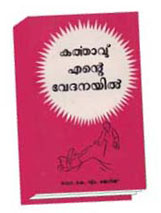 |
||||||
SADHU MATHAICHEN (A MULTI-FACETED CHRISTIAN YOGI) |
|||||||
Sadhu Mathaichen; a great Indian Christian sage who left an indelible mark on the Christians in Kerala, one who left a sacrificial life through love and service, a man who exemplified the life of ancient saints of Indian culture to the full, one in whom traditions of the Indian Sadhu and the evangelical Christian so beautifully blended, an exemplary ideal for human development, a “Saddhu” who attracted many a young man to evaluate one’s own values of life, a man of spiritual fragrance – a special quality which surpassed all cultivated experience of world – a spirit directed life which originated from Christ and pointed men and women not to him but to Him. His ever smiling face radiated peace and serenity, attracted many like a magnet, a happy synthesis of asceticism and selfless love, a unique contribution of conviction, courage, strength of character, selfless love. The bases of all these qualities stemmed from the complete loyalty and devotion to his Lord and Master Jesus Christ.
|
 |
||||||
| CHURCH OF INDIA : NEGOTIATIONS TOWARDS UNION (1919-1947) | |||||||
The Church of South India, a Union of at least three great Christian traditions and ecclesiastical systems took place on September 27, 1947; this Union was hailed as ‘the greatest forward step in Church unity in modern times’, ‘a venture of faith’, ‘a momentous achievement in unity’, ‘a beacon in our Christian world’. After receiving the vision of St. John 21:17 ‘that they all may be one’, the humble beginning at Tranquebar (1919) experienced by 33 Christian leaders, the Founding Fathers had to travel for a long period of time – nearly three decades – to achieve the goal. This book is an attempt to draw out salient features of unflagging negotiations, discussions, meetings, hurdles, set backs, disappointments, and contributions of a number of Christian leaders to see the final consummation of the great Union. (The book is published by the author, printed at Graphic Systems, Mallappally, and distribution by CSS Tiruvalla, pages 132 in 1997)
|
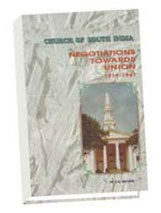 |
||||||
|
CHURCH OF SOUTH INDIA LIFE IN UNION (1947-1997) |
|||||||
The Church of South India is one of the finest fruits of twentieth century ecumenism; first in the history of the Christendom of a union of Churches coming from both Episcopal and non-Episcopal traditions. The book is an attempt to highlight various facets of the life of the Church of South India; its life in union since its inauguration in 1947 up to the present day. It deals with a short history of each of the dioceses, Synod: its functions and achievements, Worship and Liturgy, Episcopacy, Parish Ministry, Union attempts with other major Churches, Mission and Evangelism, Women’s Work, Laity Work, Theological Commission, and Evaluation of the successes and failures of the Church during the last fifty years. It is hoped that further study of the life of the Church would be undertaken by Church historians. (The book is a joint publication of Indian Society for the Propagation of the Gospel (Delhi) and Christava Sahitya Samithi, Tiruvalla; 292 pages in 1999)
|
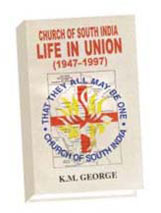 |
||||||
|
DEVELOPMENT OF CHRISTIANITY THROUGH THE CENTURIES : TRADITION AND DISCOVERY |
|||||||
(Published by Christava Sahitya Samithy, Tiruvalla, 495 pages, published in 2005) The book is the history of worldwide Christianity. The book has two parts. The chapters in Part I deal with important events that have taken place in Christianity over the last 2000 years. Part II deals with Christianity in nearly 170 countries covering topics as the coming of Christianity, its development and the present situation in each country. The last chapter is an overview of Christianity, which draws together the main trends in the book. (The Most Rev. Dr Philipose Mar Chrysostom Mar Thoma Metropolitan in commending the book wrote: “It is a Herculean task to compress a span of two thousand years of Christianity, which spills over the five continents with its varying traditions and practices in 14chapters. Yet Dr. George did it”).
|
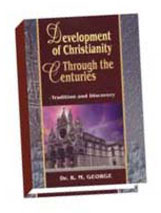 |
||||||
|
|
|||||||
|
CHRISTIANTITY IN INDIA THROUGH THE CENTURIES |
|||||||
Chapterwise Pdf format of the Book is available Chapter 1.Global Scenario of the Indian Church Pdf format of the Book Christianity in India through Centuries.(Whole Book)
|
|||||||
Christianity has its roots in the East. The apostles took up with courage and conviction the challenge and responsibility to ‘go into the world and preach the gospel everywhere’. The teachings of Jesus reached well beyond the Jews, transforming the moral and spiritual life of individuals of different classes and races. The increasing mobility of people and the growth of cosmopolitanism have also encouraged the expansion of Christianity. Christianity in India through the centuries starts with the global scenario of the Indian Church in the early days of Christianity, deals with the impact of Indian Christianity on society and finally emphasises the challenges for the Indian Church of the 21st century. (The book is published by OM Authentic Media (simultaneously in (India, UK and USA), published in 2007, 382 pages)
|
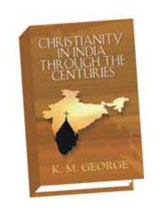 |
||||||
| HISTORICAL DEVELOPMENT OF EDUCATION IN DEVELOPING STATE , Sabah 1891-1991 | |||||||
The book is the dissertation on Historical Development of Education in a Developing State Sabah 1881-1981 submitted to the Columbia Pacific University, California for his Doctorate degree in 1988. As this thesis was based on the development of education in Sabah, the Government of Sabah was interested in getting it published for which his permission was sought and I gave my assent to their request. The Government of Sabah published the book in 2002, pages 302.
|
 |
||||||
| A SHORT HISTORY OF C M S HIGH SCHOOL, PUNNAVELI | |||||||
This booklet contains a brief history of C M S High School Punnaveli. There was very little education opportunities existed in Punnaveli towards the end of the 19th century. In 1897 a Malalayam Primary School was started, and for English education pupils had to go to Mallappally CMS School or CMS College School, Kottayam. In 1920 an English Middle School was started with K A Mathai as headmaster. In 1957 the school was raised to the level of a High School. The school has served as beacon of light in the region having produced many a great personality who served or are serving in different parts of India and foreign countries. (The book was published by the Platinum Jubilee Committee in 1995, and printed at Graphic Systems, Mallappally; 40 pages)
|
 |
||||||
| KAVUMKOTTETHU KUDUMBA CHARITHRAM (Malayalam) (History of Kavumkottethu family) | |||||||
(This book was published by the Kudumba Yogam committee in 2000, pages 180) |
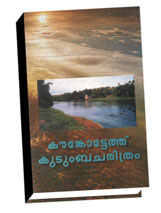 |
||||||
| IN THE FOOTSTEPS OF HIS MASTER LIFE AND WITNESS OF BISHOP T B BENJAMIN | |||||||
Long life is a gift from God. The completion of a centenary of life is certainly a special blessing conferred on very special people. The Rt Rev T B Benjamin is such a privileged person. He completed 101 years on May 17, 2008. The main emphasis of this Festchrift volume “In the Footsteps of his Master” in honour of the Rt Rev, T B Benjamin highlights a vision for humanity, a living philosophy of sharing based on Biblical faith, love and justice, and a sense of concern and caring of the less fortunate and under privileged members of the society through the life and witness of this great servant of God. The main contributors are drawn from ecclesiastical fraternity, priests, and lay leaders including leading personalities from judiciary, civil service, academicians, theologians, scientists and journalists. The book contains a number of articles. They include messages from bishops, reflections from certain dignitaries, the impact of Bishop Benjamin on different individuals and groups, his special talents in dealing with very difficult and complex situations emerging as am outstanding administrator, his great sense of compassion, great ability as a renowned teacher expounding great biblical faith and his humane relationships with less fortunate and down trodden members of society. (The book is published by Christava Sahitya Samaithy, TIruvalla, 2008 pages 204}
|
 |
||||||
| CONTEMPORARY HISTORY OF SABAH | |||||||
| Knowledge of events which have shaped the history of a country is crucial to enable their people to avoid the mistakes of the past in their quest for a progressively better life. This book, a compilation of the history of Sabah as part of the centenary year programme is not an academic exercise merely the interest to scholars and researchers but as an understanding with much wider implications for the present and future well-being of the people. The book contains a 60 pages articles pertains to all aspects of the State from 18981 to 1981. They include Administration, Political, Economic, and Social Development. K M George’s part in this book is writing 60 page articles on the Historical Development of Education in Sabah (This book is published by the Sabah Government State Department Centenary Celebration Committee in 1981, 600 pages) |  |
||||||
| Selfless to the Core ‘Selfless to the Core’ is the Life and witness of Bishop E A L Moore, the fourth Bishop of the Anglican Church of Travancore and Cochin from 1925-1937. A few of the church leaders had the following to say about the book. Rt Rev.Dr.Sam Mathew (Retired Bishop of the CSI Madhya Kerala Diocese says: “By this precious book the author has highlighted our fading memories of the Anglican Bishop E.A.L. Moore whose name future generations should keep in their hearts with deep reverence: Rev. Dr. E. John (Renowned Biblical Scholar and retired Principal of United Theological College, Bangalore writes: ‘Selfless to the Core’ is an enlightening narrative of the life and witness of a people’s bishop, a church leader who has left a noble example of a deeply devout and ascetic life. This book is a lucid and percolating narrative of Bishop Moore.” Prof Rev K.C. Mathew (First Principal of Bishop Moore College, Mavelikara says: “Dr K.M. George’s book on the Rt Rev. E A.L.Moore highlighted many qualities of the great bishop who was a role model and continues to be so even now. The fading memories of this selfless saintly bishop are again highlighted by this book”. This book is published by Bishop Moore Golden Jubilee Committee, Mavelikara in 2012. It contains 200 pages and priced at Indian Rupees 180 only. |
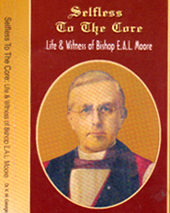 |
||||||
| Tradition Versus Reform Tradition versus Reform deals with the ‘Mission of Help’ of the Church Missionary Society (1816-1840) with the Malabar Syrian Church. It was an ecumenical attempt between the very ancient Church of St Thomas Christians with its great tradition and the Protestant English Church with its evangelical fervour which lasted for just a quarter of a century. Some of the church leaders had this to say about the book. Rt Rev. Dr Sam Mathew says: “Dr K.M. George is a veteran leader of the Church and a great church historian. This small history book is a great asset to the students of Church History. I congratulate him for having taken so much pain to write this history book”. Rev. Dr. E.C. John (Renowned Biblical Scholar and Retired Principal of United Theological College Bangalore says: “We owe a deep debt of gratitude to Dr K M George for putting in much effort to examine all the printed minutes and other references relating to the work of the early missionaries in Travancore and Cochin... The result is a very reliable book written in lucid style.” Rev Dr George Oommen (Formerly Professor of History of Christianity United Theological College Bangalore says: “Dr K M George’s work is a well-timed and analytical account of how CMS missionaries laid the foundations for reform in Christian orthodoxy in Orthodox Christianity in Kerala. With his characteristic fluency for nuanced historical detail, Dr George beautifully captures how CMS missionaries were initiated and drawn into Kerala’s social and cultural landscape. He describes how the early missionaries went about achieving their goals, their challenges, their learning curves, their successes and their failures”. Fr. Dr T I Varghese (Professor of Church History, Orthodox Theological Seminary Kottayam has this to say: “Although there were several scholarly, historically and missiologically oriented books of the CMS Mission published by authors in and out of Kerala; yet Dr George’s latest book is not an overview of what already had been explored. Dr George, as a sincere and committed Christian desires to say something glorious about the earlier missionaries and their mission endeavour, which I believe is the uniqueness of the book... This ecumenical perspective vision of Dr Georg to see things in a matured dimension deserves admiration from all Christians and non-Christians alike.” This book is published by Benjamin Bailey Foundation, Kottayam contains 200 pages and is priced at Indian Rupees Two hundred only. |
|||||||
|
|||||||
 |
 |
||||||
| Un Published Work | |||||||
A Reference Book of three volumes comprising over 900 pages on History of Education in Sabah (1881-1981) was written at the request of Sabah Foundation, Kota Kinabalu. It was completed and presented to the Honourable Chief Minister of Sabah on November 30, 1981 for the use of those interested on the above subject to be kept in the Sabah Foundation Library in Kota Kinabalu
|
|||||||
All rights reserved. Copyright 2010 - 11 © K M George.
Website created by  www.webtechnologies.co.in www.webtechnologies.co.in |
|||||||